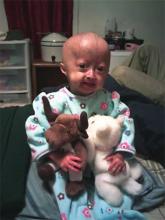A 3-month-old white female presented with dysmorphic facial features, failure to thrive, and areas of thickened skin that developed shortly after birth. She was born full term with an uncomplicated pregnancy and an unremarkable family history. Cutaneous exam revealed patchy alopecia and shiny skin with diffuse patterned atrophic and sclerotic patches across her buttocks, abdomen, and back.
What’s your diagnosis?
Skin changes may be the earliest clue to the diagnosis of Hutchinson-Gilford progeria syndrome (HGPS), according to Victoria Williams, at student at Baylor College of Medicine, Houston, who presented the case at the Society for Pediatric Dermatology annual meeting.
"In an infant, sclerodermatous plaques or localized morphea should raise the suspicion of a premature aging syndrome, particularly HGPS, when additional dysmorphic features are present," said Ms. Williams.
The differential diagnosis in an infant with dysmorphic features, failure to thrive, and sclerotic skin lesions includes HGPS, Werner syndrome, acrogeria, mandibuloacral dysplasia, and restrictive dermopathy. Congenital viral infection must also be considered.
On exam, however, the infant exhibited classic – though not fully developed – HGPS dysmorphia: mild frontal bossing; prominent eyes and venous patterning over her nose and glabella; small, low-set ears; thin lips; micrognathia; and a small nose with a flattened nasal bridge and anteverted tip.
She had findings consistent with morphea on left flank biopsy, including an increase in density and homogeneity of dermal connective tissue and an increase in dermal fibroblast cellularity.
The diagnosis was confirmed by sequencing LMNA, the gene that codes for the nuclear envelope protein, lamin A. Progeria has recently been linked to point mutations in exon 11 of the gene, most commonly c.1824C>T.
The patient lacked that mutation, but had two others also thought to disrupt the exon. The first, described as c.1968+1G>A, had been previously reported in a patient with restrictive dermopathy that shares some features with HGPS, Ms. Williams said.
The girl’s second mutation was a heterozygous intronic difference, not previously reported that "may contribute to the disease phenotype of HGPS," Ms. Williams said.
The syndrome’s estimated incidence is 1 per 4-8 million births. It is characterized by growth retardation and premature senescent changes within the skin, bones, and cardiovascular system. Death comes on average at age 13, often from heart attack or stroke.
As in Ms. William’s patient, HGPS generally presents before 2 years of age with failure to thrive, alopecia, skin changes, loss of subcutaneous tissue, and associated dysmorphic features.
By age 1 year, the patient had developed the characteristic sagittal alopecia and a wide gait.
After diagnosis, she was referred to the Progeria Research Foundation in Boston and enrolled in a phase II trial of the farnesyltransferase inhibitor, lonafarnib, which is being tested to reduce the amount of pathogenic protein products produced by the mutated gene.
The patient, now age 3 years, is tolerating the assigned trial therapy but continues to demonstrate progressive multiorgan senescent changes, and has fully developed the characteristic HGPS facial features.
"Early recognition of the features of HGPS is important for prompt diagnosis, intervention to control the effects of this disease, and genetic counseling," said Ms. Williams.
Ms. Williams reported no conflicts of interest.



